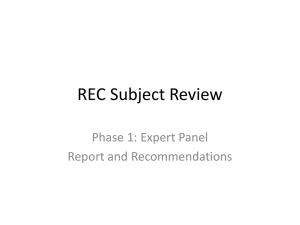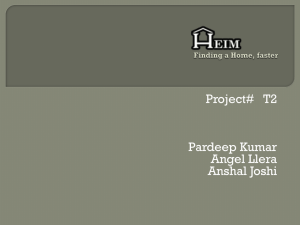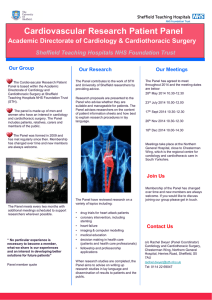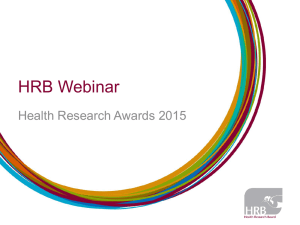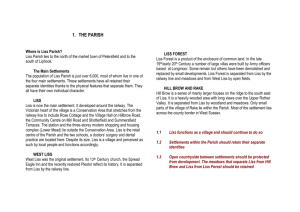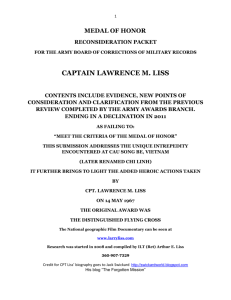The Dutch MESS project
advertisement
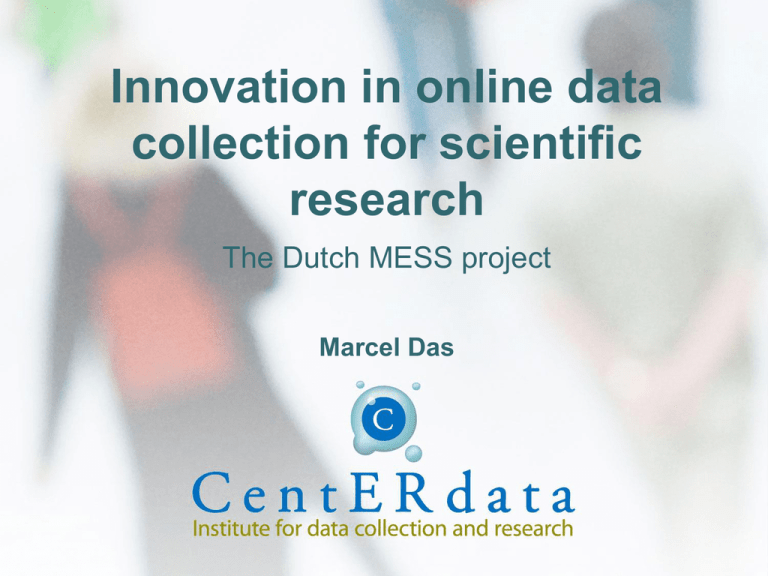
Innovation in online data collection for scientific research The Dutch MESS project Marcel Das MESS Project Purpose: to build an advanced data collection environment for the social sciences 2 9-4-2015 Maximal opportunities for innovation Multidisciplinary Fast Cost effective Easy to use for everyone in the scientific community Central element MESS project: the LISS panel Online panel of 5,000 households 8,000 individuals (>= 16 years) Questionnaires each month, 30 min. Incentive € 15 (≈ ₩ 21,500) per hour 3 9-4-2015 At no cost if for scientific use LISS panel Online interviews as method, but: Probability sample drawn from address sampling frame of Statistics Netherlands Includes households without Internet access (less than 15%): CentERdata provides equipment 4 9-4-2015 Contacted by letter, telephone or visit simPC Very small and silent Only the most frequently used functions Automatic maintenance, virus protected Simple operation and readable screens 5 9-4-2015 Installation and support Non-response patterns Similar to those of other leading scientific panels Superior to commercial access and volunteer panels: - no coverage problems - no self-selection 6 9-4-2015 Attention for attrition Refreshment sample in 2009 (stratified) and 2011 (random), in close collaboration with Statistics Netherlands 7 9-4-2015 Number of registered households by subsamples; Jan 2008 - July 2012 Source: Scherpenzeel et al. 2012 Non-Internet households (Leenheer and Scherpenzeel, 2012) Who are they? Do we get them in the panel? Are participants representative? Do they stay in the panel? Do they stay representative or do they start to use the Internet more frequently? 9 9-4-2015 Results of study Who are they? Differ in many ways from Internet hh Get them in the panel? Difficult to get into the panel Representative? In panel: representative with respect to age, household size and origin Stay in the panel? Loyal and reliable panel members Stay representative? About half remain “Non-Internet” 10 9-4-2015 Using Internet does not change the answers to questions Use of the LISS panel New data collection Academic researchers, irrespective of nationality, can use the LISS panel at no cost Proposals can be submitted throughout the year (see http://www.lissdata.nl) Available data (free of charge) 11 9-4-2015 Proposed studies Longitudinal core study Longitudinal Core Study Questions were designed in close collaboration with experts in the relevant fields Core study borrows from various national and international surveys (to facilitate comparisons with other data sources) Topics: Household and family, Economic situation and housing, Work and schooling, Social integration and leisure, Health, Personality, Religion and ethnicity, Politics and values 12 9-4-2015 Wave 5: Nov 2011 to June 2012 Innovation in data collection methods 13 9-4-2015 Advanced weighing scales Device that measures body weight and fat percentage, wirelessly transmitted to LISS database Provided to 1,000 households in LISS panel 2011: 80,000 measurements 14 9-4-2015 Data can be linked to a wealth of socioeconomic variables Weekly weight cycle 15 Source: Kooreman and Scherpenzeel, 2012 Accelerometer study Device provides aggregate indices of activity through the day (24 hours) Wearing the device for 8 days September 2012: feasibility pilot among 200 LISS respondents 16 9-4-2015 International collaboration: American Life Panel (ALP) English Longitudinal Study of Aging (ELSA) Smartphone data collection Time Use Research (TUR) usually carried out using questionnaires and diaries current technology: smartphones and “apps” 17 9-4-2015 Also: after consent, connect diary to movements measured by GPS Pilot experiments (Fernee et al., 2012) Currently < 25% of LISS respondents has smartphone with Internet access Explore the possibility to loan smartphones to LISS respondents 50 respondents with Android smartphone download app from Android Play-store 50 respondents without Android smartphone app was already installed 18 9-4-2015 Response 19 9-4-2015 Day 1: Wednesday Smartphone owners (50) Inexperienced users (50) Day questions uploaded (complete) 40 27 Partially complete 2 15 No observations 3 7 Never logged in 5 1 Day 2: Saturday Smartphone owners (50) Inexperienced users (50) Day questions uploaded (complete) 37 46 Partially complete 9 1 No observations 3 0 Never logged in 1 3 Smartphones: next steps September 2012: start collecting the actual TUR data on iPhones, Android (loan) smartphones (in cooperation with The Netherlands Institute for Social Research) One year: each month a different batch of about 170 respondents 20 9-4-2015 Next to the TUR study: - Project measuring travel behavior (GPS) - Software development for smartphones Linking to admin data Expands the possibilities for scientific research enormously Statistics Netherlands offers a remote access facility to (registered) researchers 21 9-4-2015 First project: merging LISS data about minimal and adequate expenditure levels during retirement with administrative data on pension entitlements and various asset categories LISS data: archive and DDI Disseminated through website / data archive: http://www.lissdata.nl Database is based on DDI 3: one of the first implementations of version 3 (DDI = Data Documentation Initiative, International XML-based standard for data documentation) 22 9-4-2015 Supports ‘Baskets’, allowing researchers to create and download custom datasets www.lissdata.nl
